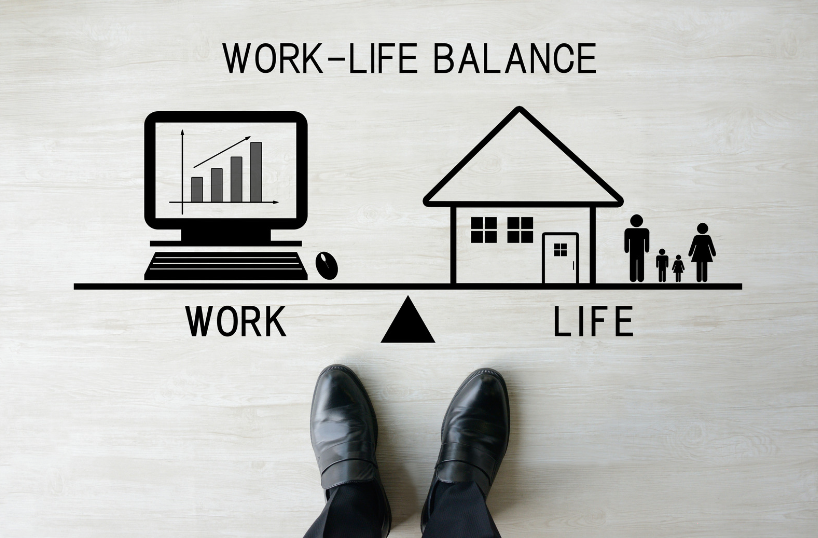Looking for the best ways to improve life balance is the dream of many people.
Do you feel like you’re constantly juggling work, personal life, and wellness? Do you find yourself feeling stressed, burned out, and overwhelmed?
If so, you’re not alone. Many people struggle to achieve a healthy work-life balance. But it doesn’t have to be that way.
In this article, we’ll explore the concept of life balance, discuss who often experiences poor life balance, and provide practical tips on how to achieve and maintain a healthy balance between work and life.
Here’s a sneak peek at what you’ll learn:
- What is life balance, and why is it important?
- Who often experiences poor life balance?
- How to identify the signs of poor life balance
- Practical tips for improving your work-life balance
Whether you’re a student, employee, freelancer, or parent, this article has something for you.
So read on and learn how to achieve a more balanced and fulfilling life.
What is life balance?

94% of employees believe that work-life balance is important. (Randstad Work-Life Balance Global Report 2023) Before you start your journey toward improving your life balance, you need to understand what it is:
Definition of Life Balance
Life balance, often referred to as work-life balance, is the equilibrium between one’s professional life and personal life.
It involves managing time, energy, and resources in a way that allows individuals to fulfill their work-related obligations while still having ample time for personal pursuits, family, and relaxation.
Importance of Life Balance
A balanced life is essential for overall well-being. It helps reduce stress, enhance relationships, and boost productivity.
When we strike a harmonious balance between our work and personal lives, we can lead more fulfilling and satisfying lives.
Signs of an Imbalanced Life
Signs of poor life balance include constant stress, a feeling of being overwhelmed, and neglect of personal health and relationships.
Recognizing these signs is the first step toward making positive changes in your life and improving your life balance.
Who Has Poor Life Balance?

57% of surveyed employees say a poor work-life balance is a deal-breaker when considering a job. (Zippia Work-Life Balance Report 2023)
Sometimes some of us are stuck in long work hours or some relationship that takes up most of our daytime; we need to be aware of how we spend our time and how we do time management the right way.
Identifying common imbalances
Poor life balance affects people across various professions and life stages. It is often seen in those who are overly focused on their careers, neglecting their personal lives, or, conversely, those who struggle with their professional commitments due to personal issues.
The Impact of Poor Life Balance
The important reason why you should improve your life balance An imbalanced life can lead to burnout, decreased job satisfaction, strained relationships, and physical and mental health issues.
It’s crucial to address these imbalances before they take a toll on your overall quality of life.
What Can Be Done for a Healthy Balance Between Work and Life?

Improve life balance for a healthy journey in life. A study by the Society for Human Resource Management found that companies with strong work-life balance programs had better employee engagement, productivity, and retention rates. You can improve your life balance and achieve your goals with these techniques:
Setting Priorities
One of the key steps in achieving life balance is setting clear priorities. By identifying what truly matters to you in both your professional and personal lives, you can allocate your time and energy more effectively.
Time management techniques
Effective time management is crucial. Techniques like creating to-do lists, using productivity tools, and eliminating time-wasting habits can help you make the most of your day.
In addition to these general time management techniques, there are also a few specific techniques that you can use to improve your productivity and efficiency. For example:
- The Pomodoro Technique The Pomodoro Technique is a time management technique that breaks down work into intervals, traditionally 25 minutes in length, separated by short breaks. This technique can help you stay focused and avoid distractions.
- Time blocking. Time blocking is a time management technique that involves scheduling specific blocks of time for specific tasks. This technique can help you avoid multitasking and make sure that you’re making progress on your most important tasks.
- Batching. Batching is a time management technique that involves grouping similar tasks together and completing them all at once. This technique can help you save time and improve your efficiency.
Stress Reduction Methods to Improve Your Life Balance

Yes, stress reduction techniques can significantly contribute to a healthier life balance. When you are stressed, your body releases hormones such as cortisol and adrenaline. These hormones can cause a variety of physical and emotional problems, including:
- Headaches
- Muscle tension
- Stomach problems
- Difficulty sleeping
- Anxiety
- Depression
Over time, chronic stress can lead to serious health problems such as heart disease, stroke, and high blood pressure.
Stress reduction techniques can help lower your cortisol levels and improve your overall health and well-being. Some effective stress reduction techniques include:
- Mindfulness. Mindfulness is the practice of paying attention to the present moment without judgment. There are many different mindfulness exercises, such as meditation, yoga, and tai chi. Mindfulness can help you become more aware of your thoughts and feelings and let go of negative thoughts and worries.
- Meditation. Meditation is a mind-body practice that involves focusing your attention on a single point, such as your breath or a mantra. Meditation has been shown to be effective in reducing stress, anxiety, and depression.
- Regular exercise. Exercise is a great way to reduce stress and improve your overall health. Aim for at least 30 minutes of moderate-intensity exercise most days of the week.
- Social support. Spending time with loved ones and talking to someone you trust can help reduce stress and improve your mood.
Prioritizing Well-being
Prioritizing well-being should be a top priority. When you take care of your physical and mental health, you are better able to handle stress, achieve your goals, and enjoy life.
Here are some tips for prioritizing well-being:
- Make your physical health a priority. Eat a healthy diet, get regular exercise, and get enough sleep.
- Take care of your mental health. Practice relaxation techniques, spend time with loved ones, and seek professional help if needed.
- Set boundaries. It’s important to set boundaries between work and personal life and to say no to commitments that you don’t have time for.
- Take breaks. Schedule time for yourself each day to relax and recharge.
- Do things you enjoy. Make time for activities that you enjoy and that make you happy.
Mindfulness and balance
Practicing mindfulness can help you stay present and fully engaged in your tasks, whether at work or in your personal life.
Here are some tips for practicing mindfulness at work:
- Take a few minutes at the start of your workday to focus on your breath and set your intentions for the day.
- Throughout the day, take breaks to focus on your breath and to check in with yourself.
- When you are working on a task, try to focus on the present moment and avoid distractions.
- If you find yourself getting distracted, gently bring your attention back to the task at hand.
- Be mindful of your interactions with others. Try to be present and engaged in each conversation.
The role of wellness
Wellness encompasses a holistic approach to a balanced life. It includes physical, emotional, and mental well-being, making it a fundamental aspect of achieving equilibrium.
Here are some tips for achieving equilibrium in your life:
- Make time for yourself each day. Schedule time for activities that you enjoy and that make you happy.
- Connect with others. Spend time with loved ones and build positive relationships.
- Take care of your physical health. Eat a healthy diet, get regular exercise, and get enough sleep.
- Manage stress in a healthy way. Learn relaxation techniques and find healthy ways to cope with stress.
- Have a positive attitude. Focus on the good things in your life and be grateful for what you have.
- Find your purpose in life. What gives your life meaning? What are you passionate about?
- Set goals for yourself. What do you want to achieve in your life?
- Be kind to yourself. Forgive yourself for your mistakes, and accept yourself for who you are.
Achieving Equilibrium for a Better Life Balance

Balancing work and life is a continuous process. It involves regular self-assessment, making adjustments, and being flexible in response to changing circumstances.
Here are some tips for achieving equilibrium in your life:
- Make time for yourself each day. Schedule time for activities that you enjoy and that make you happy.
- Connect with others. Spend time with loved ones and build positive relationships.
- Take care of your physical health. Eat a healthy diet, get regular exercise, and get enough sleep.
- Healthily manage stress. Learn relaxation techniques and find healthy ways to cope with stress.
- Have a positive attitude. Focus on the good things in your life and be grateful for what you have.
- Find your purpose in life. What gives your life meaning? What are you passionate about?
- Set goals for yourself. What do you want to achieve in your life?
- Be kind to yourself. Forgive yourself for your mistakes, and accept yourself for who you are.
Tips for a Healthy Life Balance

Improve your life balance with our expert tips for a healthy you:
- Time Management Tips: Learn effective time management techniques, such as setting boundaries for work hours and allocating dedicated time for personal activities.
- Delegation and Saying “No”: Don’t hesitate to delegate tasks when possible, and learn to say “no” when additional commitments would disrupt your life balance.
- Self-Care Strategies: Incorporate self-care activities into your daily routine, such as exercise, relaxation, and pursuing hobbies you enjoy.
- Creating Boundaries: Set clear boundaries between work and personal life, ensuring that one doesn’t encroach on the other.
- Setting Realistic Goals: Establish realistic and achievable goals in both your professional and personal life to reduce stress and boost your sense of accomplishment.
Resources and Support Roles in Enhancing Life Balance

Resources and support play a big role in improving life balance.
Seeking professional help
- A study by the American Psychological Association found that 70% of people who sought professional help for work-life balance reported significant improvement.
- A study by the Society for Human Resource Management found that companies with employee assistance programs (EAPs) that offer work-life balance counseling had lower absenteeism rates and higher employee satisfaction rates.
Online Resources
A healthy work-life balance will mean different things to us all. It’s not so much about splitting your time 50/50 between work and leisure, but making sure you feel fulfilled and content in both areas of your life.
A healthy balance could be:
- A study by the Pew Research Center found that 72% of adults have used the Internet to find information about health and wellness.
- A study by the University of California, Berkeley, found that online self-help programs for work-life balance can be just as effective as traditional therapy.
Supportive Communities
- A study by the University of Pennsylvania found that people who participate in support groups are more likely to achieve their goals and less likely to experience relapse.
- A study by the National Alliance on Mental Illness found that support groups can help to improve mental health, reduce social isolation, and increase emotional well-being.
If you are struggling to achieve work-life balance, consider seeking professional help, using online resources, and joining a supportive community. There are many resources and support options available to help you on your journey to equilibrium.
In addition to the above, here are some additional tips for finding resources and support for work-life balance:
- Talk to your doctor or a mental health professional. They can recommend resources and support options that are right for you.
- Ask your employer about any work-life balance resources or support programs that they offer.
- Search online for resources and support groups in your area.
- Join online forums and communities focused on work-life balance.
Conclusion
A healthy life balance is achievable with determination and the right strategies.
You can improve life balance by setting priorities, managing your time effectively, reducing stress, and prioritizing your well-being. You can create a life where work and personal pursuits coexist harmoniously. Striving for equilibrium is an ongoing process, but the rewards in terms of reduced stress, improved relationships, and enhanced well-being make it all worthwhile.
FAQs
Achieving life balance requires setting clear priorities, effective time management, stress reduction techniques, self-care, and maintaining boundaries between work and personal life.
The five steps to achieving a healthy work-life balance are setting priorities, effective time management, stress reduction, prioritizing well-being, and practicing mindfulness.
Balancing your life at home involves setting clear boundaries, allocating time for self-care, and practicing effective time management techniques.
Life balance, or work-life balance, means maintaining an equilibrium between your professional responsibilities and your personal life, ensuring both coexist harmoniously.
Life balance is important because it reduces stress, enhances relationships, improves overall well-being, and boosts productivity, leading to a more fulfilling and satisfying life.

